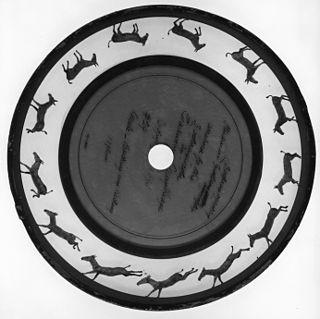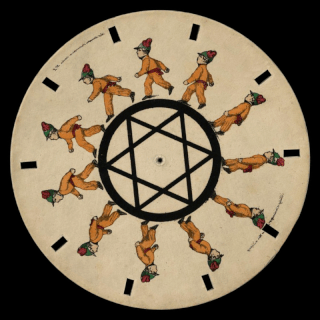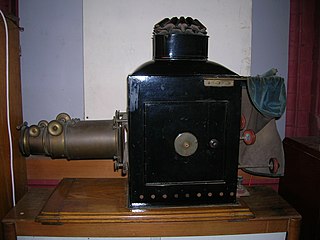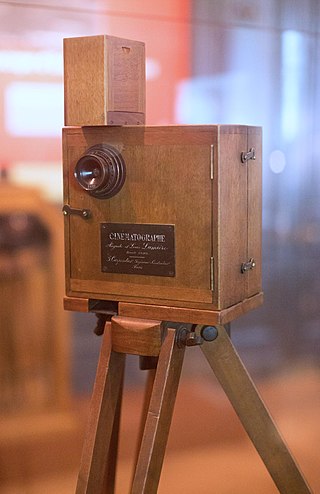Related Research Articles

The magic lantern, also known by its Latin name lanterna magica, was an early type of image projector that used pictures—paintings, prints, or photographs—on transparent plates, one or more lenses, and a light source. Because a single lens inverts an image projected through it, slides were inserted upside down in the magic lantern, rendering the projected image correctly oriented.

A zoetrope is a pre-film animation device that produces the illusion of motion, by displaying a sequence of drawings or photographs showing progressive phases of that motion. A zoetrope is a cylindrical variant of the phénakisticope, an apparatus suggested after the stroboscopic discs were introduced in 1833. The definitive version of the zoetrope, with replaceable film picture film strips, was introduced as a toy by Milton Bradley in 1866 and became very successful.

A slide projector is an optical device for projecting enlarged images of photographic slides onto a screen. Many projectors have mechanical arrangements to show a series of slides loaded into a special tray sequentially.

An overhead projector, like a film or slide projector, uses light to project an enlarged image on a screen, allowing the view of a small document or picture to be shared with a large audience.

The zoopraxiscope is an early device for displaying moving images and is considered an important predecessor of the movie projector. It was conceived by photographic pioneer Eadweard Muybridge in 1879. Muybridge used the projector in his public lectures from 1880 to 1895. The projector used 16" glass disks onto which Muybridge had an unidentified artist paint the sequences as silhouettes. This technique eliminated the backgrounds and enabled the creation of fanciful combinations and additional imaginary elements. Only one disk used photographic images, of a horse skeleton posed in different positions. A later series of 12″ discs, made in 1892–1894, used outlines drawn by Erwin F. Faber that were printed onto the discs photographically, then colored by hand. These colored discs were probably never used in Muybridge's lectures. All images of the known 71 disks, including those of the photographic disk, were rendered in elongated form to compensate the distortion of the projection. The projector was related to other projecting phenakistiscopes and used some slotted metal shutter discs that were interchangeable for different picture disks or different effects on the screen. The machine was hand-cranked.

The phenakistiscope was the first widespread animation device that created a fluid illusion of motion. Dubbed Fantascope and Stroboscopische Scheiben by its inventors, it has been known under many other names until the French product name Phénakisticope became common. The phenakistiscope is regarded as one of the first forms of moving media entertainment that paved the way for the future motion picture and film industry. Similar to a GIF animation, it can only show a short continuous loop.

A movie projector is an opto-mechanical device for displaying motion picture film by projecting it onto a screen. Most of the optical and mechanical elements, except for the illumination and sound devices, are present in movie cameras. Modern movie projectors are specially built video projectors.

The opaque projector, or episcope is a device which displays opaque materials by shining a bright lamp onto the object from above. The episcope must be distinguished from the diascope, which is a projector used for projecting images of transparent objects, and from the epidiascope, which is capable of projecting images of both opaque and transparent objects.

The Geneva drive or Geneva mechanism is a gear mechanism that translates a continuous rotation movement into intermittent rotary motion.

An intermittent mechanism or intermittent movement is a device or movement which regularly advances an object, web, or plastic film and then holds it in place. This process is commonly used in industry and manufacturing.

Precursors of film are concepts and devices that have much in common with the later art and techniques of cinema.

Jules Carpentier was a French engineer and inventor.

A projector or image projector is an optical device that projects an image onto a surface, commonly a projection screen. Most projectors create an image by shining a light through a small transparent lens, but some newer types of projectors can project the image directly, by using lasers. A virtual retinal display, or retinal projector, is a projector that projects an image directly on the retina instead of using an external projection screen.

The history of film technology traces the development of techniques for the recording, construction and presentation of motion pictures. When the film medium came about in the 19th century, there already was a centuries old tradition of screening moving images through shadow play and the magic lantern that were very popular with audiences in many parts of the world. Especially the magic lantern influenced much of the projection technology, exhibition practices and cultural implementation of film. Between 1825 and 1840, the relevant technologies of stroboscopic animation, photography and stereoscopy were introduced. For much of the rest of the century, many engineers and inventors tried to combine all these new technologies and the much older technique of projection to create a complete illusion or a complete documentation of reality. Colour photography was usually included in these ambitions and the introduction of the phonograph in 1877 seemed to promise the addition of synchronized sound recordings. Between 1887 and 1894, the first successful short cinematographic presentations were established. The biggest popular breakthrough of the technology came in 1895 with the first projected movies that lasted longer than 10 seconds. During the first years after this breakthrough, most motion pictures lasted about 50 seconds, lacked synchronized sound and natural colour, and were mainly exhibited as novelty attractions. In the first decades of the 20th century, movies grew much longer and the medium quickly developed into one of the most important tools of communication and entertainment. The breakthrough of synchronized sound occurred at the end of the 1920s and that of full color motion picture film in the 1930s. By the start of the 21st century, physical film stock was being replaced with digital film technologies at both ends of the production chain by digital image sensors and projectors.
For the history of animation after the development of celluloid film, see history of animation.
Events in 1870 in animation.
Events in 1869 in animation.
Events in 1866 in animation.
Events in 1860 in animation.
References
- ↑ "Choreutoscope". Museum of the History of Science. Retrieved 20 November 2019.
- ↑ "Pre-cinema resources". www.museudelcinema.cat. Retrieved 20 November 2019.
- ↑ US93594A,"Optical instrument",issued 10 August 1869
- ↑ Popular Educator a Complete Encyclopaedia of Elementary, Advanced, and Technical Education. Cassell. 1870. pp. 248–249, 304.
- ↑ "The Physical Chemistry of the Photographic Process". The Photographic Journal. 64. The Royal Photographic Society of Great Britain and the Photographic Alliance: 59–61. 1924.